Mistwalker ( Brian Griffin ) was kind enough to send me a Schrade SCHF9 some time back to do a review on it and give some feedback on its design and functionality.
Mistwalker was , to his credit more interested in the design and functionality of the knife rather then just a receiving a sycophantic ‘thumbs up’. I decided to forward the Knife onto someone entirely impartial to give it an honest appraisal and solid no-holds barred review.
The person I approached was Joe ‘O’Leary from the Wilderness Survival School
http://www.wilderness-survival.co.uk/joe-oleary/
I have a lot of time for Joe’s opinion and thought he would be a good test subject to provide a detailed review of the knife design and its functionality and ability to be applied to wilderness /Bushy applications.
I was also going to provide my own review but after making my own notes and then seeing Joes I think he has pretty much nailed it all and echos my own experience and views on the knife design and size.
I think the use of ‘larger’ knifes in the bushy world still do have a place although we in the UK for a variety of reasons seem mostly to be opposed to this, I find it hard to believe that the Mountain Men of the Old American Rockies and the Finnish Saami people who choose to use Leukko and Pukkoi combination were using the ‘wrong’ tools for the Northern Forest environment.
There also seems to be a possibly perceived negative connation connected to owners and users of large knives and blades especially in the UK? This doesn’t seem to extend to Axe ownership.
I still consider a knife a direct pressure cutting tool and for chopping you will never be able to compete with an Axe or Hatchet just due to the physics and blade geometery involved. You will also never be able to compete with a folding Saw for cutting Straight through wood with an Axe or Knife , tools by their nature are specialist creatures for specialized tasks. The downside of that is that you then have to carry a range of tool which means more equipment = more weight.
The larger knife could be considered to be a Jack-of-all-trades that can be used to complete a range of tasks.
One of the reasons I like this particular Knife design is most larger blades are just that , Longer Blades, With a longer handle which the SCHF9 Has its possible to use in a multitude of ways , you can 'choke' up near the primary edge and use it for finer cutting tasks or if needed drop right back to the rear of the handle and using the very rear of the palm choil use it to really generate some leverage in chopping action when required.
If a knife possesses a longer blade then a handle it seems its primary function has been overlooked or its design is more orientated to the 'tactical' blade market. Thankfully the Schrade has neither and the longer handle provides a very useful design feature.
Below is Joe’s review and many thanks to Joe for providing the review and for Mistwalker for providing the knife to review.
Schrade Extreme Survival Knife review Joe O'Leary:
I can remember when starting out down the bushcraft and survival training path in the mid 1980’s, being influenced by the trend at the time, for large, heavy bladed ‘do everything’ survival knives. I think John J had a big hand in it somewhere! These knives ranged from the £20 hollow handled beasts that looked very capable (but clearly weren’t) to the more expensive and well thought out members of the same family such as the Gerber BMF, Wilkinsons sword survival knife and various Chris Reeve models.
As my interest in the traditional crafts element of bushcraft grew, my needs changed slightly and for the last decade or more I have been favouring the small axe, folding or collapsible saw and 4” fixed blade sheath knife combination. A more traditional and versatile set up for back country living with likely origins ranging from Scandinavian forest folk through to the pioneers of the Canadian far North. Traditional forged steel, scandi grinds and well worn brown leather sheaths have formed the core of my kit list for some time and have served me well but I still remember those black cordura clad, saw tooth spined, dulled steel 10” bowie blades with fondness.
So when I was recently asked to test a new heavy duty survival knife I jumped at the chance. After all, it’s been years since I last carried one cutting tool to do everything and since then, my expectations have grown considerably. This would be an interesting exercise with a bit of nostalgia thrown in for good measure.
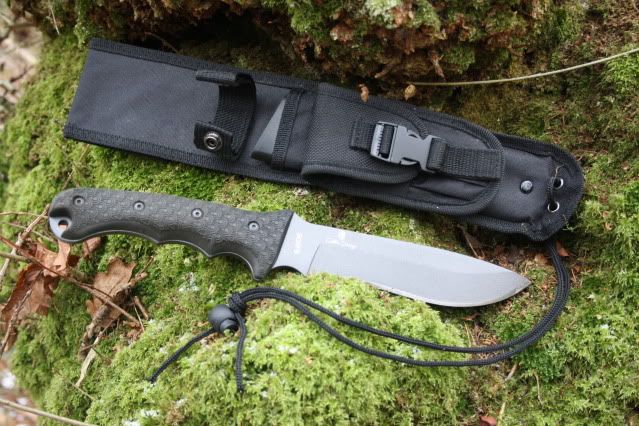 http://i267.photobucket.com/albums/ii301/tarquinwagstaffe/Joe-long_term_shelter_178.jpg
http://i267.photobucket.com/albums/ii301/tarquinwagstaffe/Joe-long_term_shelter_178.jpg
The knife in question is a ‘Schrade Extreme Survival Knife’ designed by Brian Griffin. I know nothing about the designer or the maker and have no preconceptions at all about the knife, it’s intended market or the story behind it’s production. I have purely been asked to put it through it’s paces and give my opinion and an honest review of it’s performance. So, I find myself in the woods on a sunny spring day, not an axe or a saw in sight and a shiny new survival tool in my backpack.
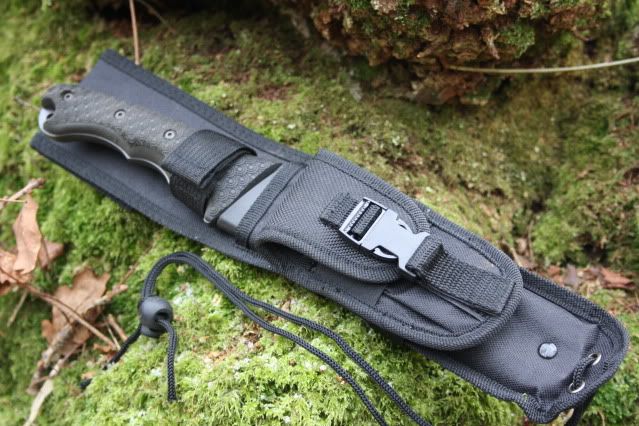
The knife:
Well…not all that shiny. Both knife and sheath have a tactical look to them. The no nonsense black cordura sheath with it’s heavy duty plastic liner surround the knife in a tight grip. Extra sheath features include a removable cordura survival kit / sharpening stone pocket and black adjustable leg lanyard. The retaining strap has a sturdy popper keeping the knife firmly where it should be and even this is covered by a black webbing strap so as to avoid any shine.
The knife itself is of a full tang design. 6mm thick, blackened steel with a 140mm contoured, finger grooved handle and 165mm blade, flat grind with 2-3mm secondary bevel. The first 23mm of the blade has a finger groove cut into it before the cutting edge starts which feels as if it gives better control of the blade when carving. Blade width starts as 33mm then swells slightly to 36mm before sweeping upwards to meet the spine. The spine drops slightly towards the tip and is of a simple squared off design (not a single saw tooth in sight). A slightly bulbous ended blade such as this would require a circular ‘puck’ style stone used in the same manner as an axe stone to keep it razor sharp.
The handle scales are made from black, solid rubber featuring a grippy pattern. These are held in place by four recessed bolts and have a gap near the rounded butt revealing a lanyard hole through the steel tang. Peeping through the rubber scales along the back of the handle is a textured section carved into the tang, presumably to help with grip where it matters. The handle belly has finger grooves carved into both rubber scales and steel tang. One minor detail noticed here is that the scales are fixed only by the bolts and could do with some glue to reduce movement or debris creeping underneath.
First impressions? I want to strap it to my lower leg (or possibly gaffer tape it upside down to my shoulder strap) abseil into the jungle and take on the first steroid enhanced, trophy hunting alien I see.
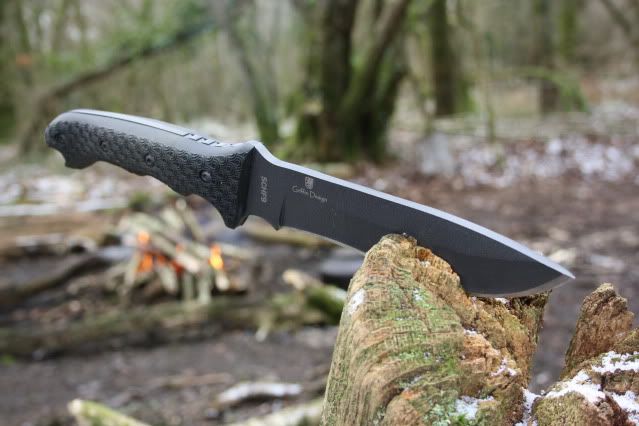
Testing:
However, as I’m in a wet Wiltshire woodland and nowhere near a jungle I decide to prepare wood for a fire instead. With the previous week or so being pretty soggy, every piece of kindling and firewood is damp, dripping or soaked. To add to the moist conditions, the cold spring air still has enough bite to make lighting a fire a job that requires full concentration and plenty of preparation so I set about cutting all my materials from standing deadwood.
I pick a thick Hazel pole that looks as if it has been ring barked by squirrels last spring and with relative ease, pull it rootstock and all from the leaf littered earth. The Schrade’s first job is to chop this long pole into smaller, more splittable sections. Finding a suitable fallen Oak log to serve as a work bench I get to work.
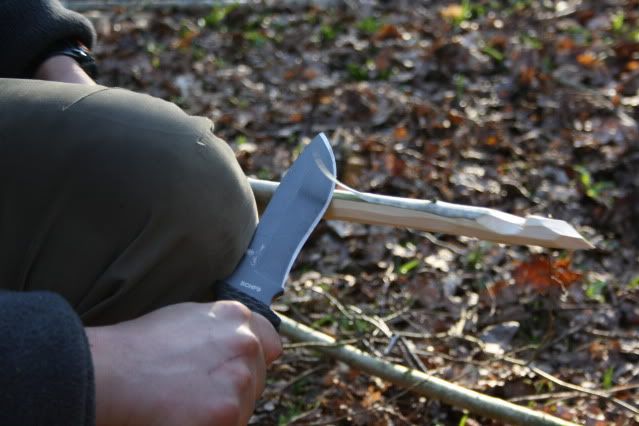
Chopping:
For a relatively small chopping blade it handles this task pretty well, cutting through the seasoned wood easily, removing good sized chunks with every chop. The large, grippy handle is easy to hold in a pair of gloved hands and the deep flat grind is quite hatchet like. The rubber scales seem to help greatly in absorbing the shock of metal striking against hard wood.
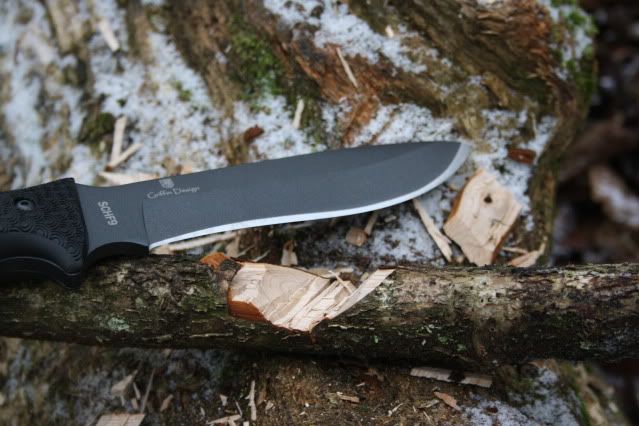
However, to gain enough momentum for a hefty swing I need to hold the handle as close as possible towards the butt end thereby lengthening the blade. This is fairly tiring on the grip. With the addition on a wrist lanyard for safety and providing the tool didn’t need to be used for chopping tasks all day, this wouldn’t be a problem. Also, care must be taken to ensure the chopping angle doesn’t become too steep as there is a tendency to lean the blade over slightly in order to remove more wood. As the blade is light compared to a hatchet or machete there is a danger of it missing it’s target and rolling as it connects, leaving the cutting edge skating along the surface of the wood. I make a mental note to refer to my usual axe safety measures when using this as a chopping tool and keep all of my fleshy bits well out of the way !
Splitting:
I take the chopped sections of Hazel and up-end them one at a time to be split along their lengths using the heaviest piece of Hazel as a batten. The thick blade of the Schrade is perfect for this task easily splitting the dry firewood into kindling. A solid full tang construction and meaty handle means that I have absolutely no fear of damaging the blade by twisting laterally to force the more stubborn wood fibres apart.
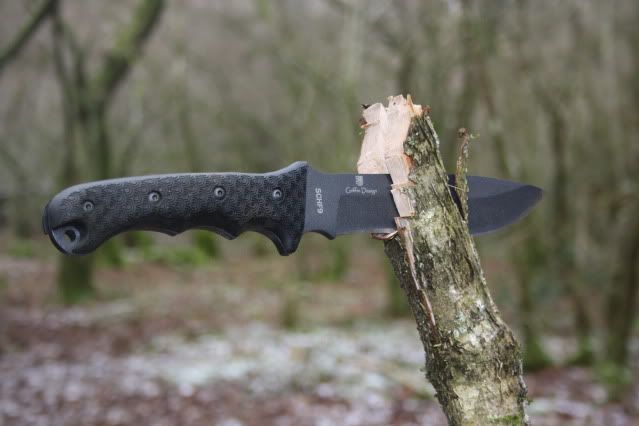 http://i267.photobucket.com/albums/ii301/tarquinwagstaffe/Joe-long_term_shelter_167.jpg
http://i267.photobucket.com/albums/ii301/tarquinwagstaffe/Joe-long_term_shelter_167.jpg
The sturdy blade grind also copes well showing no signs of damage after cleaving apart knots and burls. At this point I have no doubt that the Schrade’s thick, no-nonsense blade could be used in conjunction with a heavy batten or maul to split or chop through much larger sections of timber if needed. A quick check of the cutting edge reveals some very good edge retention after working it hard in cold weather on seasoned wood.
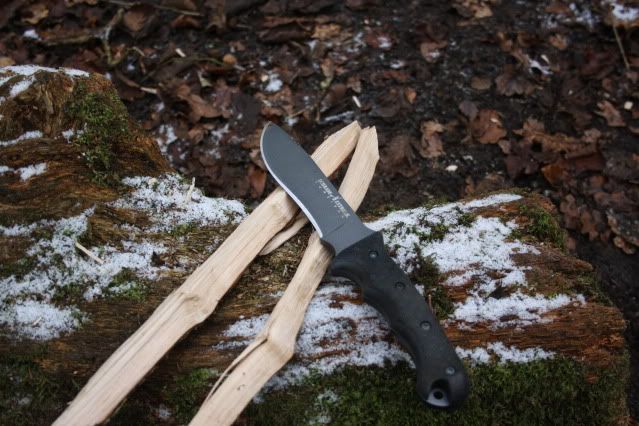 http://i267.photobucket.com/albums/ii301/tarquinwagstaffe/Joe-long_term_shelter_169.jpg
http://i267.photobucket.com/albums/ii301/tarquinwagstaffe/Joe-long_term_shelter_169.jpg
Carving:
With all the Honeysuckle and Birch bark hanging limply off the trees like wet washing I decide to test the knife further by carving my dry kindling down into fine shavings to act as tinder. This is the point where large bladed survival tools often fall flat on their backsides and at first the Schrade seems to confirm that assumption. The thick blade and hefty handle are difficult to control when attempting to carve feather sticks and I feel like a clumsy novice struggling with a basic skill. Additionally, the extra blade length and weight sap my energy making me more likely to make a mistake or slip. Silently I vow to get back to the gym and train my forearms more often.
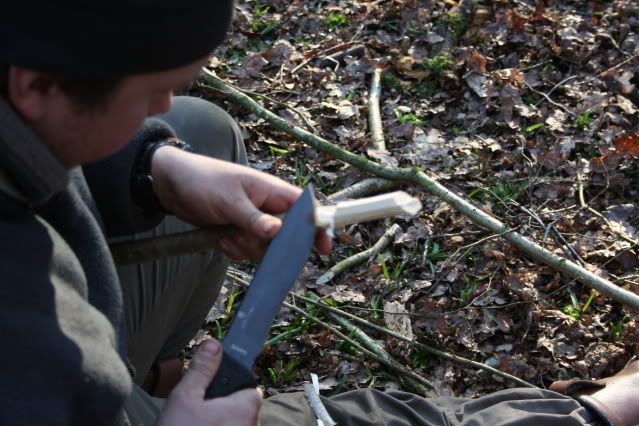
A bit of experimentation is called for and by altering my carving techniques I very quickly notice an improvement. Of course! Heavy bladed tools like this are much more energy efficient to use if they are held still while the wood is moved against the blade. I try holding the blade like a draw knife which seems to work ok. Then I try holding the substantial spine of the blade against my knee cap and carefully pulling each section of kindling back over the cutting edge. This works like a dream and before long, finely carved feather sticks a plenty appear at my side, ready to light. The sharp edge between spine and blade produces an impressive shower of sparks from my Swedish Fire steel lighting the most fine and feathery shavings and in a very short time sparks become warming flames.
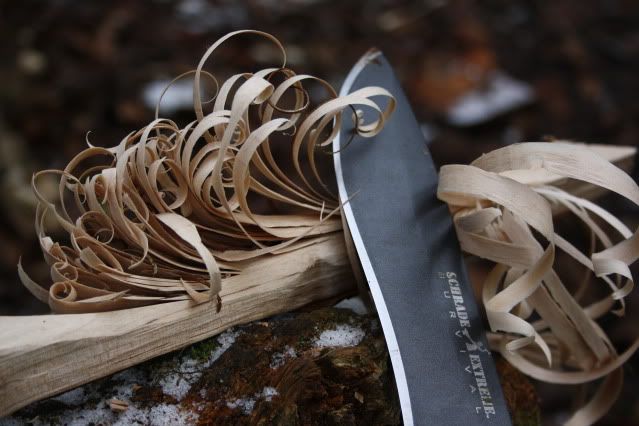
I spend the rest of the day using the Scrade for various back country tasks from shelter building work and a primitive trapping demonstration to chopping vegetables for a stew (luckily I like my carrots chopped big and still have sharp eyes to find them as the thick blade cleaves the little orange sections with such force that each and every one goes whizzing off my chopping board and into the undergrowth). It proves itself to be particularly useful in cutting and slicing green wood having enough weight behind it to accomplish the desired cut with a single chop.
Summary:
This is a sturdy and well thought out survival tool, perfect for including in a grab bag or as an occasionally used cutting companion. As a serious bushcraft tool in the hands of someone who intends to work and chop wood all day long it would have less value and there are better, more productive, energy saving alternatives. However, it has to be said that those alternatives would probably weigh three times as much as the Schrade. This is a tool that copes extremely well with a variety of survival tasks. It’s a good all rounder and I’m sure that as a survival knife, this has always been the makers intention. Therefore I conclude that the Schrade Extreme Survival knife does everything it promises to do and more. It has the strength and bomb proof build of a survivor backed up by good edge retention and is still small and light enough to be included in a belt kit or shoulder bag style survival pack. As an added bonus, I hear the price is so reasonable for a knife of this quality that a forward thinking outdoors person could easily afford to buy more than one to stash in a safe place, just in case…
Mistwalker was , to his credit more interested in the design and functionality of the knife rather then just a receiving a sycophantic ‘thumbs up’. I decided to forward the Knife onto someone entirely impartial to give it an honest appraisal and solid no-holds barred review.
The person I approached was Joe ‘O’Leary from the Wilderness Survival School
http://www.wilderness-survival.co.uk/joe-oleary/
I have a lot of time for Joe’s opinion and thought he would be a good test subject to provide a detailed review of the knife design and its functionality and ability to be applied to wilderness /Bushy applications.
I was also going to provide my own review but after making my own notes and then seeing Joes I think he has pretty much nailed it all and echos my own experience and views on the knife design and size.
I think the use of ‘larger’ knifes in the bushy world still do have a place although we in the UK for a variety of reasons seem mostly to be opposed to this, I find it hard to believe that the Mountain Men of the Old American Rockies and the Finnish Saami people who choose to use Leukko and Pukkoi combination were using the ‘wrong’ tools for the Northern Forest environment.
There also seems to be a possibly perceived negative connation connected to owners and users of large knives and blades especially in the UK? This doesn’t seem to extend to Axe ownership.
I still consider a knife a direct pressure cutting tool and for chopping you will never be able to compete with an Axe or Hatchet just due to the physics and blade geometery involved. You will also never be able to compete with a folding Saw for cutting Straight through wood with an Axe or Knife , tools by their nature are specialist creatures for specialized tasks. The downside of that is that you then have to carry a range of tool which means more equipment = more weight.
The larger knife could be considered to be a Jack-of-all-trades that can be used to complete a range of tasks.
One of the reasons I like this particular Knife design is most larger blades are just that , Longer Blades, With a longer handle which the SCHF9 Has its possible to use in a multitude of ways , you can 'choke' up near the primary edge and use it for finer cutting tasks or if needed drop right back to the rear of the handle and using the very rear of the palm choil use it to really generate some leverage in chopping action when required.
If a knife possesses a longer blade then a handle it seems its primary function has been overlooked or its design is more orientated to the 'tactical' blade market. Thankfully the Schrade has neither and the longer handle provides a very useful design feature.
Below is Joe’s review and many thanks to Joe for providing the review and for Mistwalker for providing the knife to review.
Schrade Extreme Survival Knife review Joe O'Leary:
I can remember when starting out down the bushcraft and survival training path in the mid 1980’s, being influenced by the trend at the time, for large, heavy bladed ‘do everything’ survival knives. I think John J had a big hand in it somewhere! These knives ranged from the £20 hollow handled beasts that looked very capable (but clearly weren’t) to the more expensive and well thought out members of the same family such as the Gerber BMF, Wilkinsons sword survival knife and various Chris Reeve models.
As my interest in the traditional crafts element of bushcraft grew, my needs changed slightly and for the last decade or more I have been favouring the small axe, folding or collapsible saw and 4” fixed blade sheath knife combination. A more traditional and versatile set up for back country living with likely origins ranging from Scandinavian forest folk through to the pioneers of the Canadian far North. Traditional forged steel, scandi grinds and well worn brown leather sheaths have formed the core of my kit list for some time and have served me well but I still remember those black cordura clad, saw tooth spined, dulled steel 10” bowie blades with fondness.
So when I was recently asked to test a new heavy duty survival knife I jumped at the chance. After all, it’s been years since I last carried one cutting tool to do everything and since then, my expectations have grown considerably. This would be an interesting exercise with a bit of nostalgia thrown in for good measure.

The knife in question is a ‘Schrade Extreme Survival Knife’ designed by Brian Griffin. I know nothing about the designer or the maker and have no preconceptions at all about the knife, it’s intended market or the story behind it’s production. I have purely been asked to put it through it’s paces and give my opinion and an honest review of it’s performance. So, I find myself in the woods on a sunny spring day, not an axe or a saw in sight and a shiny new survival tool in my backpack.

The knife:
Well…not all that shiny. Both knife and sheath have a tactical look to them. The no nonsense black cordura sheath with it’s heavy duty plastic liner surround the knife in a tight grip. Extra sheath features include a removable cordura survival kit / sharpening stone pocket and black adjustable leg lanyard. The retaining strap has a sturdy popper keeping the knife firmly where it should be and even this is covered by a black webbing strap so as to avoid any shine.
The knife itself is of a full tang design. 6mm thick, blackened steel with a 140mm contoured, finger grooved handle and 165mm blade, flat grind with 2-3mm secondary bevel. The first 23mm of the blade has a finger groove cut into it before the cutting edge starts which feels as if it gives better control of the blade when carving. Blade width starts as 33mm then swells slightly to 36mm before sweeping upwards to meet the spine. The spine drops slightly towards the tip and is of a simple squared off design (not a single saw tooth in sight). A slightly bulbous ended blade such as this would require a circular ‘puck’ style stone used in the same manner as an axe stone to keep it razor sharp.
The handle scales are made from black, solid rubber featuring a grippy pattern. These are held in place by four recessed bolts and have a gap near the rounded butt revealing a lanyard hole through the steel tang. Peeping through the rubber scales along the back of the handle is a textured section carved into the tang, presumably to help with grip where it matters. The handle belly has finger grooves carved into both rubber scales and steel tang. One minor detail noticed here is that the scales are fixed only by the bolts and could do with some glue to reduce movement or debris creeping underneath.
First impressions? I want to strap it to my lower leg (or possibly gaffer tape it upside down to my shoulder strap) abseil into the jungle and take on the first steroid enhanced, trophy hunting alien I see.

Testing:
However, as I’m in a wet Wiltshire woodland and nowhere near a jungle I decide to prepare wood for a fire instead. With the previous week or so being pretty soggy, every piece of kindling and firewood is damp, dripping or soaked. To add to the moist conditions, the cold spring air still has enough bite to make lighting a fire a job that requires full concentration and plenty of preparation so I set about cutting all my materials from standing deadwood.
I pick a thick Hazel pole that looks as if it has been ring barked by squirrels last spring and with relative ease, pull it rootstock and all from the leaf littered earth. The Schrade’s first job is to chop this long pole into smaller, more splittable sections. Finding a suitable fallen Oak log to serve as a work bench I get to work.

Chopping:
For a relatively small chopping blade it handles this task pretty well, cutting through the seasoned wood easily, removing good sized chunks with every chop. The large, grippy handle is easy to hold in a pair of gloved hands and the deep flat grind is quite hatchet like. The rubber scales seem to help greatly in absorbing the shock of metal striking against hard wood.

However, to gain enough momentum for a hefty swing I need to hold the handle as close as possible towards the butt end thereby lengthening the blade. This is fairly tiring on the grip. With the addition on a wrist lanyard for safety and providing the tool didn’t need to be used for chopping tasks all day, this wouldn’t be a problem. Also, care must be taken to ensure the chopping angle doesn’t become too steep as there is a tendency to lean the blade over slightly in order to remove more wood. As the blade is light compared to a hatchet or machete there is a danger of it missing it’s target and rolling as it connects, leaving the cutting edge skating along the surface of the wood. I make a mental note to refer to my usual axe safety measures when using this as a chopping tool and keep all of my fleshy bits well out of the way !
Splitting:
I take the chopped sections of Hazel and up-end them one at a time to be split along their lengths using the heaviest piece of Hazel as a batten. The thick blade of the Schrade is perfect for this task easily splitting the dry firewood into kindling. A solid full tang construction and meaty handle means that I have absolutely no fear of damaging the blade by twisting laterally to force the more stubborn wood fibres apart.

The sturdy blade grind also copes well showing no signs of damage after cleaving apart knots and burls. At this point I have no doubt that the Schrade’s thick, no-nonsense blade could be used in conjunction with a heavy batten or maul to split or chop through much larger sections of timber if needed. A quick check of the cutting edge reveals some very good edge retention after working it hard in cold weather on seasoned wood.

Carving:
With all the Honeysuckle and Birch bark hanging limply off the trees like wet washing I decide to test the knife further by carving my dry kindling down into fine shavings to act as tinder. This is the point where large bladed survival tools often fall flat on their backsides and at first the Schrade seems to confirm that assumption. The thick blade and hefty handle are difficult to control when attempting to carve feather sticks and I feel like a clumsy novice struggling with a basic skill. Additionally, the extra blade length and weight sap my energy making me more likely to make a mistake or slip. Silently I vow to get back to the gym and train my forearms more often.

A bit of experimentation is called for and by altering my carving techniques I very quickly notice an improvement. Of course! Heavy bladed tools like this are much more energy efficient to use if they are held still while the wood is moved against the blade. I try holding the blade like a draw knife which seems to work ok. Then I try holding the substantial spine of the blade against my knee cap and carefully pulling each section of kindling back over the cutting edge. This works like a dream and before long, finely carved feather sticks a plenty appear at my side, ready to light. The sharp edge between spine and blade produces an impressive shower of sparks from my Swedish Fire steel lighting the most fine and feathery shavings and in a very short time sparks become warming flames.

I spend the rest of the day using the Scrade for various back country tasks from shelter building work and a primitive trapping demonstration to chopping vegetables for a stew (luckily I like my carrots chopped big and still have sharp eyes to find them as the thick blade cleaves the little orange sections with such force that each and every one goes whizzing off my chopping board and into the undergrowth). It proves itself to be particularly useful in cutting and slicing green wood having enough weight behind it to accomplish the desired cut with a single chop.
Summary:
This is a sturdy and well thought out survival tool, perfect for including in a grab bag or as an occasionally used cutting companion. As a serious bushcraft tool in the hands of someone who intends to work and chop wood all day long it would have less value and there are better, more productive, energy saving alternatives. However, it has to be said that those alternatives would probably weigh three times as much as the Schrade. This is a tool that copes extremely well with a variety of survival tasks. It’s a good all rounder and I’m sure that as a survival knife, this has always been the makers intention. Therefore I conclude that the Schrade Extreme Survival knife does everything it promises to do and more. It has the strength and bomb proof build of a survivor backed up by good edge retention and is still small and light enough to be included in a belt kit or shoulder bag style survival pack. As an added bonus, I hear the price is so reasonable for a knife of this quality that a forward thinking outdoors person could easily afford to buy more than one to stash in a safe place, just in case…
Last edited:
